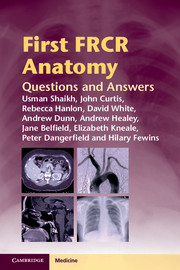Examination 1
Published online by Cambridge University Press: 05 March 2012
Summary
Postero-anterior (PA) chest radiograph
Left brachiocephalic vein. The left brachiocephalic vein forms a silhouette with the adjacent lung. This interface ‘fades’ above the clavicles as it becomes more anteriorly placed and ‘merges’ with the anterior chest wall.
Pulmonary trunk.
Right atrium (right heart border).
Right cardiophrenic recess.
Azygos fissure. The azygos fissure is seen in 0.5% of chest radiographs. It is formed by the caudal invagination of the azygos vein through the apex of the right upper lobe. It begins as a line in the upper portion and extends in an arc caudally toward the ‘teardrop’ density that is the azygos vein. The azygos vein is outside the parietal pleura – the line is therefore composed of two visceral and two parietal pleural layers. The so-called azygos ‘lobe’ is the segment of lung between the fissure and the trachea. It is not a true separate ‘lobe’ as the total bronchial anatomy in the right upper lobe has not been altered even though there may be minor variations in the bronchial supply to this segment of upper lobe.
Coronal neonatal ultrasound through the anterior fontanelle
Left lateral ventricle. The combined width of the lateral ventricles on coronal imaging should be less than a third of the total width of the intracranial fossa at the same level.
Corpus callosum.
Superior sagittal sinus. Colour flow and Doppler can be used to assess venous sinus patency.
Right temporal lobe.
Pons.
- Type
- Chapter
- Information
- First FRCR AnatomyQuestions and Answers, pp. 23 - 30Publisher: Cambridge University PressPrint publication year: 2012

